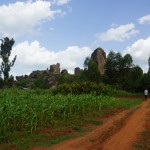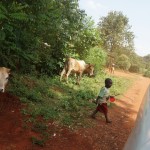So many of you have asked me what a mission trip to Africa is like. I wanted to share with you Jim Shelburne’s blog of his recent trip there with me. Jim is one of our great supporters at CRF and such a great encouragement to me. And he is also a good writer. He preaches at the Washington Avenue Christian Church. The experiences of his journey will inspire you . Maybe he will motivate you to go with us next time.
-Milt
_________________________
On this fifth day in Africa we did not drive many total miles, but the ones we drove were on absolutely the worst roads I’ve ever traversed. The mountain roads in this region are dirt, washed out and rutted deeply, with potholes the size of Texas, alternated with  iceberg-sized boulders that stand at just the perfect height to rip out the oil pan of any naïve vehicle that’s stupid enough to venture onto the road. Here near the equator the climate is temperate, the growing season long, the rainy season regular and faithful. These rural roads thread through what certainly has to be some of the most gorgeous land in the world, much of it planted in terraced rows of corn and cabbage and collard greens about as far as the eye can see in any direction. The verdant vistas across these roads are beautiful; but the prayer and confession required to travel these roads severely limits the scenic enjoyment. Stated another way, the roads are too frightening to allow for much scenic enjoyment–or much enjoyment of any kind– unless you favor off-roading as a hobby.
iceberg-sized boulders that stand at just the perfect height to rip out the oil pan of any naïve vehicle that’s stupid enough to venture onto the road. Here near the equator the climate is temperate, the growing season long, the rainy season regular and faithful. These rural roads thread through what certainly has to be some of the most gorgeous land in the world, much of it planted in terraced rows of corn and cabbage and collard greens about as far as the eye can see in any direction. The verdant vistas across these roads are beautiful; but the prayer and confession required to travel these roads severely limits the scenic enjoyment. Stated another way, the roads are too frightening to allow for much scenic enjoyment–or much enjoyment of any kind– unless you favor off-roading as a hobby.
These roads are heavily traveled by pedestrians, bicycles and motorcycles. This is partly true because many of them are in such a condition as to not be suitable for travel in any vehicle that is not mostly tank, or of a two-wheeled variety. I would be willing to bet that few people have ever gone where we went today in a Toyota minivan! Even the locals were amazed! What Stephen our driver did today is right up there with Jesus walking on water; tales of his great automotive prowess (Stephen’s, not Jesus’) will echo through generations in the Mt. Elgon region of Kenya; near the end of our journey we presented Stephen with a trophy and proclaimed him “The Best Driver in the World.” He simply took us places you cannot drive in a minivan, and we lived to tell about it. No tow truck was required, and no tires were changed. It was miraculous! You may be wondering why we attempted such a feat; as difficult as they are to traverse, these roadways are the only ones that go to the places we went today, so they are important. It would seem clear that the government has no actual awareness of them, as they are carefully maintained every 9 or 10 years. We managed to visit three schools today, only falling 5 hours behind in our schedule; I’ll write about those visits in another post. But while I’m still vibrating from the day’s journey, the sheer terror and excitement provided by driving thus far in Africa has caused me to come up with some rules for driving that may prove useful if you ever find yourself behind the wheel on the Dark Continent. (These rules are meant to be somewhat tongue-in-cheek, and in no way to ridicule Kenya or those brave enough to drive in it; they are, however, much closer to the truth than you might imagine!) I fully expect to see these in KEN-DOT publications the next time I go to Africa.
Some Rules for the Road while touring Africa:
- Nothing is too long or too large or too heavy to carry on a bicycle, along with your wife and four children. If you have a motorcycle, double that. A limit to the number of passengers on two-wheeled conveyances exists, and the number seems to be about 5, but might be stretched to 7, warranting certain necessities.
- There is no speed too fast when on a paved, or unpaved straightaway, even if the stretch of open road is only 50 yards long and even if it is not open roadway.
- There is no speed slow enough to travel on rural mountain roads.
- There are almost no posted traffic laws except one that is universal and absolute: drive on the left side of the road, unless you can drive faster on the right.
- Passing on mountains and blind curves is fine if you can pull it off.
- You cannot come too close to killing a pedestrian, bicyclist or motorcyclist until you actually do.
- Using your cell phone while driving is quite acceptable; using two at the same time is better!
- Potholes happen. Use any means necessary to avoid them. Any means!
- Seat belts are not required; they simply slow the response time of bystanders who are trying to remove your badly injured body from your burning car.
- The driver has no significant responsibility for the pedestrians, motorcyclists, or bicyclists he is bearing down on at 110 KPH; however, the thoughtful driver will
 provide a gentle honk at the last possible moment which may cause the startled pedestrian, motorcyclist or bicyclist to veer into the path of the vehicle now ten feet from his body; if it happens, it is the pedestrian, motorcyclist, or bicyclist’s fault anyway. Press on.
provide a gentle honk at the last possible moment which may cause the startled pedestrian, motorcyclist or bicyclist to veer into the path of the vehicle now ten feet from his body; if it happens, it is the pedestrian, motorcyclist, or bicyclist’s fault anyway. Press on. - There is no part of the road, or off of the road for that matter, that is unacceptable for use by the driver at any time.
- When it rains so hard that visibility is impaired, the driver should speed up so as to more quickly exit the storm.
- If a certain part of the road should become impassible, say due to flooding, the driver should pull off of the road and drive through the deeper water rushing underneath the roadway.
- A vehicle’s passenger capacity has not been reached until the trunk (the boot) and all cargo compartments are filled with human beings. If the removal of any number of said human beings allows for shifting and slippage of the passengers inside the vehicle, this means there are not enough people in the conveyance, and the driver must stop at the next crossroads and take on more passengers.
- (A corollary to the previous rule) The exit from the vehicle of two passengers means that three more must board at the next stop.
- If a slight mechanical malfunction occurs, say, the side door of the matatu van falls off, the van must keep on moving. Schedules are schedules after all.
- A driver should constantly monitor the road and traffic conditions present and completely disregard them at all times.
- If there should occur an accident resulting in a collision of two vehicles, (and trust me, there should occur a lot more of them!) the driver should pull off to the side of the road, look back in his mirror carefully, and then leave very quickly if the victim (as seen in rear view) is uninjured enough as to be making aggressive progress toward the driver.
- When approaching a military checkpoint manned by soldiers with AK-47s, the appropriate response is to slow, smile, wave and drive on through.A two-lane road does not mean there is room for two vehicles. There is actually room for two large trucks, side by side, with a matatu minivan in between them, and a dozen pedestrians on each side, plus a third large truck, if need be.
- Speed bumps exist philosophically to bring order to the chaos; slowing down very much for them is a sign of weakness. Only the strong survive the roads in Kenya!
If you’re reading this and think I’m exaggerating, you haven’t driven in Kenya yet! I left my good friend Francis Bii with a few heartfelt and urgent words: “Whatever you do my friend, buckle up and turn off the cell phone. At least one of them!

